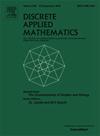The thickness of a graph with constraint on girth
IF 1
3区 数学
Q3 MATHEMATICS, APPLIED
引用次数: 0
Abstract
The thickness of a graph , denoted by , is the minimum integer such that can be decomposed into planar subgraphs. In 1991, Dean et al. conjectured that the thickness of a graph with edges is at most . In this paper we show that the conjecture holds if the girth of is at least five, and that if , where . If the girth of is not restricted, then we prove that where , which improves the known bound for the thickness of graphs. If is a connected nonplanar graph with girth which is 2-cell embedded in the orientable surface (the nonorientable surface , respectively), then
(,respectively). Clearly, if or is fixed, then the aforementioned bounds get closer and closer to 4, as the girth is larger and larger
有周长约束的图的厚度
图G的厚度,用θ(G)表示,是使G可以分解成t个平面子图的最小整数t。1991年,Dean等人推测有m条边的图G的厚度不超过m/16+O(1)。本文证明了当g的周长g≥5时,θ(g)<;1+m/2s当g≥6时,该猜想成立,其中s=⌊g/2⌋。如果G的周长不受限制,则证明了θ(G)≤⌊5/6+2m/9 - 23/36⌋,其中m≥3,改进了已知图的厚度界。若G是一个周长G≥6的连通非平面图,其2单元嵌入在可定向曲面Sk(分别为不可定向曲面Nh)中,则θ(G)≤3+⌊2k−1s⌋(θ(G)≤3+⌊h−1s⌋)。显然,如果k(≥1)或h(≥2)是固定的,那么随着周长g越来越大,上述边界越来越接近4
本文章由计算机程序翻译,如有差异,请以英文原文为准。
求助全文
约1分钟内获得全文
求助全文
来源期刊

Discrete Applied Mathematics
数学-应用数学
CiteScore
2.30
自引率
9.10%
发文量
422
审稿时长
4.5 months
期刊介绍:
The aim of Discrete Applied Mathematics is to bring together research papers in different areas of algorithmic and applicable discrete mathematics as well as applications of combinatorial mathematics to informatics and various areas of science and technology. Contributions presented to the journal can be research papers, short notes, surveys, and possibly research problems. The "Communications" section will be devoted to the fastest possible publication of recent research results that are checked and recommended for publication by a member of the Editorial Board. The journal will also publish a limited number of book announcements as well as proceedings of conferences. These proceedings will be fully refereed and adhere to the normal standards of the journal.
Potential authors are advised to view the journal and the open calls-for-papers of special issues before submitting their manuscripts. Only high-quality, original work that is within the scope of the journal or the targeted special issue will be considered.
 求助内容:
求助内容: 应助结果提醒方式:
应助结果提醒方式:


